Applications
Music and Performing Arts
E-coustic Systems can dramatically improve the listening experience in spaces that are acoustically deficient for musical performance.
 Small venues often lack the internal volume required to develop optimum acoustical characteristics for music. Frequently, these venues must support other types of performances and presentations that have both different and conflicting acoustical requirements. E-coustic Systems enables a venue to successfully host a wide array of programming, and provide optimum acoustical conditions for each performance.
Small venues often lack the internal volume required to develop optimum acoustical characteristics for music. Frequently, these venues must support other types of performances and presentations that have both different and conflicting acoustical requirements. E-coustic Systems enables a venue to successfully host a wide array of programming, and provide optimum acoustical conditions for each performance. Museo de Arts, Puerto Rico
 Separate volumes within a space such as a balcony or under balcony often have completely different listening characteristics than the main seating area. The E-coustic Systems Mainframe III is equipped to provide independent acoustical processing for each. While one acoustics "engine" can be used to optimize the main volume, the other can create acoustics that integrate acoustically separate coupled areas, making listening conditions uniform throughout the venue.
Separate volumes within a space such as a balcony or under balcony often have completely different listening characteristics than the main seating area. The E-coustic Systems Mainframe III is equipped to provide independent acoustical processing for each. While one acoustics "engine" can be used to optimize the main volume, the other can create acoustics that integrate acoustically separate coupled areas, making listening conditions uniform throughout the venue. Elgin Theatre
 In many venues, the E-coustic Systems design can accommodate signals for sound reinforcement, special effects, or for film surround, which are distributed independently to the E-coustic Systems loudspeaker array. For example, the E-coustic Systems installation in the Elgin Theatre in Toronto, Ontario is utilized for Dolby surround when the venue hosts the Toronto Film Festival annually. This added flexibility enables multipurpose venues to successfully accommodate a wide variety of performances and artists.
In many venues, the E-coustic Systems design can accommodate signals for sound reinforcement, special effects, or for film surround, which are distributed independently to the E-coustic Systems loudspeaker array. For example, the E-coustic Systems installation in the Elgin Theatre in Toronto, Ontario is utilized for Dolby surround when the venue hosts the Toronto Film Festival annually. This added flexibility enables multipurpose venues to successfully accommodate a wide variety of performances and artists.Smithsonian McEvoy Auditorium
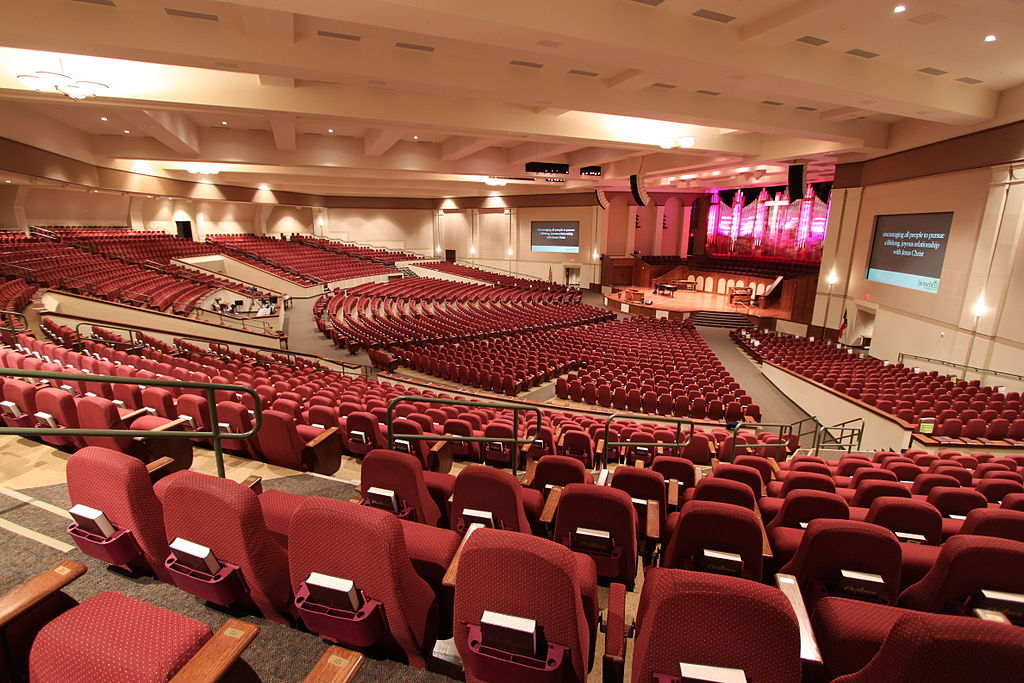
Stonebriar Community Church
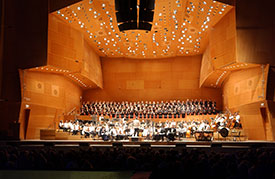
Acoustics engines in the Mainframe III can be assigned to loudspeakers on stage to both improve communication across the platform, as well as provide acoustical conditions that promote optimal performance. Unlike other systems, no additional microphones or dedicated microphone/loudspeakers channels are required. E-coustic Systms patented time variant processing provides an enourmous increase in gain before feedback that enables the system to support the full dynamic range of the largest ensembles., and the flexibility to operate with a variety of stage configurations.
Jay Pritzker Pavilion - Grant Park Music Festival Festival
Opera and Ballet
Achieving optimum acoustics for opera requires striking the balance between support and articulation for singers on the stage, and impact and envelopment for the orchestra - which may be located in pit below the stage. The size of the venue, its geometry, and architectural features like boxes and balconies often create very different listening conditions throughout the space. This is often very difficult to resolve using architectural solutions. E-cousic Systems can deliver the optimum ratios of direct, reflected and reverberant energy to each section of the venue - creating a more uniform acoustical environment and improving listening enjoyment throughout the venue.
 Smaller spaces such as the Berlin Staatsoper have relatively short distances between the principals and the patrons that create an intimate acoustical experience. The geometry of such spaces combined with low internal volume provides ample acoustic level, but with sonic quality that is that lacking in richness and envelopment for the orchestra. E-coustic Systems unique signal processing provides independent control over both the level and decay of reflected and reverberant energy. The system provides significantly improved envelopment for the orchestra without affecting the clarity and intimacy of the singers.
Smaller spaces such as the Berlin Staatsoper have relatively short distances between the principals and the patrons that create an intimate acoustical experience. The geometry of such spaces combined with low internal volume provides ample acoustic level, but with sonic quality that is that lacking in richness and envelopment for the orchestra. E-coustic Systems unique signal processing provides independent control over both the level and decay of reflected and reverberant energy. The system provides significantly improved envelopment for the orchestra without affecting the clarity and intimacy of the singers.
 Some Opera's have large stages with numerous lifts and/or turntables that can segment the stage to accommodate complex stage scenery. When the stage is sufficiently large, timing from the orchestra in the pit to the principals and chorus can become challenging. E-Shell can restore critical timing and provide uniform acoustic return of the orchestra throughout the stage area. The E-Performance system increases richness and blending of instruments in the pit without compromising impact and clarity of the singers.
Some Opera's have large stages with numerous lifts and/or turntables that can segment the stage to accommodate complex stage scenery. When the stage is sufficiently large, timing from the orchestra in the pit to the principals and chorus can become challenging. E-Shell can restore critical timing and provide uniform acoustic return of the orchestra throughout the stage area. The E-Performance system increases richness and blending of instruments in the pit without compromising impact and clarity of the singers.
Brazilian Opera - Theatro Municipal, Sao Paulo Brazil
 E-COUSTIC SYSTEMS can provide unrivaled acoustical dexterity which can enable a large venue to successfully program for artists in residence, Festival events, and a wide variety of touring performances. In the Adelaide Festival Center Theatre, independent E-coustic Systems processing is incorporated in both the house and the stage. This allows the venue to successfully present Opera and Ballet with the orchestra in the pit, and Symphony with musicians positioned on the raised stage extension. The stage system can be adjusted independently from the house, and provides a uniform sense of hall return throughout the stage area. The renovated Theatre with E-coustic Systems installed debuted Wagner's Ring Cycle, which was met with high critical acclaim from reviewers worldwide.
E-COUSTIC SYSTEMS can provide unrivaled acoustical dexterity which can enable a large venue to successfully program for artists in residence, Festival events, and a wide variety of touring performances. In the Adelaide Festival Center Theatre, independent E-coustic Systems processing is incorporated in both the house and the stage. This allows the venue to successfully present Opera and Ballet with the orchestra in the pit, and Symphony with musicians positioned on the raised stage extension. The stage system can be adjusted independently from the house, and provides a uniform sense of hall return throughout the stage area. The renovated Theatre with E-coustic Systems installed debuted Wagner's Ring Cycle, which was met with high critical acclaim from reviewers worldwide.
Music Rehearsal and Recording
MUSIC REHEARSAL
 E-coustic Systems enables a rehearsal space to become more than a “practice room”. The system acoustically transports musicians to a variety of environments – each delivering the sonic conditions that enable them to hear and play optimally. In addition, custom settings can be programmed into the system, allowing it to provide the acoustical characteristics of a specific environment - such as a hall or performing arts venue that that exists elsewhere within facility. This allows groups to practice for a performance while immersed in the acoustics of the performance space without having to schedule time in the performance space to do so.
E-coustic Systems enables a rehearsal space to become more than a “practice room”. The system acoustically transports musicians to a variety of environments – each delivering the sonic conditions that enable them to hear and play optimally. In addition, custom settings can be programmed into the system, allowing it to provide the acoustical characteristics of a specific environment - such as a hall or performing arts venue that that exists elsewhere within facility. This allows groups to practice for a performance while immersed in the acoustics of the performance space without having to schedule time in the performance space to do so.
E-coustic Systems enhances creativity – it allows musicians to experience the way different environments affect how they play or sing – both in solo settings as well as in an ensemble. Hence it also creates an indispensable coaching environment that enables immediate comparisons on how instrumental technique and environmental acoustics interact.
RECORDING, SOUND STAGE

E-coustic Systems processing provides the acoustic conditions that enable ensembles to both hear one another and play at their best. It affords enormous flexibility in acoustic delivery, enabling the recording environment to take on the characteristics of a wide variety of spaces – yet its processing is transparent to recording process. DiMenna Center for Classical Music


Sweetwater has constructed a new facility that incorporates both a unique presentation theatre as well as world class recording studios designed by Russ Berger. From the outset, these spaces were designed to work in concert with one another. The natural acoustics of the theatre are extremely neutral, and allow for both high Definition media presentations with 5.1 Dolby surround sound, as well as high energy sound reinforcement. The E-coustic Systems installation transforms the acoustic of the space – providing optimum conditions for acoustic music. Dedicated acoustics processing is assigned to the stage – allowing conditions to be independently adjusted for the musicians. The facility layout allows the concert grand piano to be easily moved between the large studio and the theatre. Tie lines and high definition video cameras and monitors throughout the facility allow these rooms to be linked, providing an unprecedented array of presentation, performance and recording scenarios.
Houses of Worship
Houses of worship require acoustics that:
- Enable the spoken word to be heard and clearly understood.
- Provide the support and envelopment required for music (organ, musicians and choir)
- Create a sense of intimacy for the congregation.
The problem is that each of these acoustic conditions conflicts with the others - even before architecture enters into the picture! Our systems are far more flexible than fixed architectural treatments. E-coustic Systems breaks the linked relationships of reverberation time and reverb level that are inherent obstacles in architectural acoustics. Direct, reflected and reverberant sound is available at the touch of a button allowing optimal conditions for congregational comfort and speech clarity to co-exist.
E-coustic Systems unique signal processing provides an enormous increase in feedback rejection, allowing microphones and loudspeakers to be placed in close proximity to one another without the consequences of coloration or howling. With E-coustic Systems, microphone counts are also dramatically reduced when compared to previous methods, and microphones can be placed close the sound source and away from intrusive noise (HVAC, lighting, etc.) Patented AutoBalance™ and Speech/Music Detection ™ enable E-coustic Systems to maintain clarity for the spoken word and envelopment for music automatically. E-coustic Systems can:
- Improve acoustical conditions and communication for a choir
- Increase Reverberation time and reverb level independently to correctly emulate increased room volume
- Provide optimum amounts of direct, reflected and reverberation to each loudspeaker throughout the space without the need for additional microphones, independent speaker arrays, or separate loudspeakers.
- Restore decoupled spaces (chancel and nave or under balcony, etc) to an acoustically unified volume
- Increase acoustic intimacy for congregational worship
- Provide multiple presets to support worship as well as music programs, orchestral performance, recitals, etc.
- Significantly improve congregational worship in contemporary services
- Provide surround sound to enhance media presentations.
TRADITIONAL SERVICE
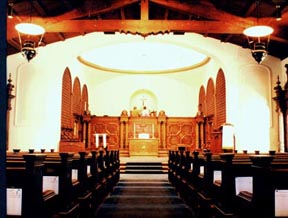
In smaller houses of worship, attaining reverberant characteristics necessary for a good musical program often means enlarging the cubic volume of the building, and hardening surfaces to increase the strength, density and duration of reflected sound in the space. Even if raising the roof or moving walls is practical, such an exercise is a construction project that will be costly and require closing the building for some time. Such changes can also create problems for speech intelligibility that did not exist prior to construction.
E-coustic Systems can provide a substantial improvement in overall acoustical balance in smaller spaces. Although loudspeakers need to be installed throughout the venue, this exercise is much simpler than reconstruction, and most often can be accomplished without disrupting primary worship services. E-coustic Systems can add energy for choir and organ - improving spaciousness, warmth and envelopment, and the feeling of intimacy within the environment. Depending on the physics of the space, the loudspeaker array can often be used as either primary or supplemental distributed sound reinforcement.
Piedmont Community Church
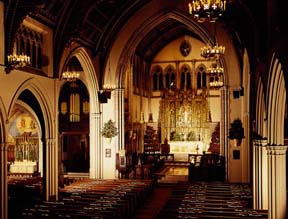 As the geometry of the venue or needs for acoustical delivery become more complex, the E-coustic Systems design can be altered to meet the challenge. If the sanctuary is large and has an antiphonal organ or choir, the timing of early and later energy from sources in both the front and rear of the space needs to be carefully accommodated and precisely delivered in order to maintain articulation. With E-coustic Systems, this is easily accomplished.
As the geometry of the venue or needs for acoustical delivery become more complex, the E-coustic Systems design can be altered to meet the challenge. If the sanctuary is large and has an antiphonal organ or choir, the timing of early and later energy from sources in both the front and rear of the space needs to be carefully accommodated and precisely delivered in order to maintain articulation. With E-coustic Systems, this is easily accomplished. St. James' Church

Some spaces have the required internal volume for optimum reverberation, but may historical surface treatments that hamper sonic quality. E-coustic Systems can be integrated invisibly to augment the reflected and reverberant energy, and provide optimum conditions for both worship and music performance.
FAN-SHAPED HOUSES OF WORSHIP

Stonebriar Community Church
CONTEMPORARY WORSHIP

12Stone Church
LARGE WORSHIP SPACES
 Maintaining optimum sound quality in a large venue presents many unique challenges. Large acoustic ensembles like a symphony orchestra that deliver ample sound power in a 2000 seat hall must rely on electro-acoustic sound reinforcement to preserve impact and clarity in large venues. Considerable amounts of acoustical treatment are required to tame long path echoes and reverberation. Even when these treatments work optimally, room geometry and distances from the listener to the surfaces make it difficult if not impossible to provide a sense of intimacy or optimum acoustical conditions for music. E-coustic systems can transform these environments, restoring impact and intimacy while concurrently providing warmth, richness, and envelopment.
Maintaining optimum sound quality in a large venue presents many unique challenges. Large acoustic ensembles like a symphony orchestra that deliver ample sound power in a 2000 seat hall must rely on electro-acoustic sound reinforcement to preserve impact and clarity in large venues. Considerable amounts of acoustical treatment are required to tame long path echoes and reverberation. Even when these treatments work optimally, room geometry and distances from the listener to the surfaces make it difficult if not impossible to provide a sense of intimacy or optimum acoustical conditions for music. E-coustic systems can transform these environments, restoring impact and intimacy while concurrently providing warmth, richness, and envelopment.
Church of Jesus Christ of Latter Day Saints - Conference Center
Other Spaces
SPORTS ARENAS

The “sound” of arenas for sporting events has become synonymous with long path echoes, loud reverberation, and long reverberation times. This perception was developed over time from facilities that were built for “utility”, with sparse acoustic treatments. Today’s modern facilities are larger, and have greater seating capacity. Increased internal volume and additional absorption decreases overall reverberation level. These space do not “energize” the fans. New facilities also have many amenities such as private boxes, club level restaraunts, etc, and must cater to functions other than sports such as ice shows, concerts etc. that require even lower reverberation time and level.
E-coustic Systems allows architects and consultants to add absorption and design the space with lower reverberation time and level, making it suitable for rock concerts, ice shows and presentations. When sports are the main attraction, E-coustic Systems adds the reflected and reverberant energy typically found in a smaller, livelier facility.
OUTDOOR SYSTEMS
 While E-coustic Systems installations dramatically improve the listening conditions in enclosed spaces, our systems can also create the warmth and envelopment of indoor venues for music that is performed outdoors. E-coustic Systems unique patented processing enables both microphones and loudspeakers to be positioned near performers, providing the acoustical conditions that enable the musicians to perform at their best. Loudspeakers positioned throughout the venue provide optimum ratios of direct, reflected and reverberant energy – substantially improving sound quality and listening enjoyment.
While E-coustic Systems installations dramatically improve the listening conditions in enclosed spaces, our systems can also create the warmth and envelopment of indoor venues for music that is performed outdoors. E-coustic Systems unique patented processing enables both microphones and loudspeakers to be positioned near performers, providing the acoustical conditions that enable the musicians to perform at their best. Loudspeakers positioned throughout the venue provide optimum ratios of direct, reflected and reverberant energy – substantially improving sound quality and listening enjoyment.
The Vienna Festival is an annual event that features the Vienna Philharmonic Orchestra on the Platz for a large open-air concert. LARES was first used in 1995, and the results were overwhelming. In a letter thanking us for our involvement, organizers stated that "this was the first time on this location with classical music that we were not criticized for spoiling the music by amplifying it". The sound company has since purchased E-coustic Systems processing for use at this event annually.
The Vienna Festival
 Millennium Park in Chicago features the Jay Pritzker pavillion. This is the new home for Grant Park Music festival which is the nation’s only remaining free, outdoor classical music series. The system includes separate E-coustic Systems processing in the pavillion that augments the natural reflected energy provided by the surfaces of the stage enclosure. The trellis was designed by Frank Gehry specifically to support sound reinforcement and E-coustic Sytems loudspeakers. Optimum amounts of direct, reflected and reverberant energy are delivered to 4000 in fixed seats and 7000 seated on the great lawn, providing the impact, richness, and envelopment of a premier concert hall.
Millennium Park in Chicago features the Jay Pritzker pavillion. This is the new home for Grant Park Music festival which is the nation’s only remaining free, outdoor classical music series. The system includes separate E-coustic Systems processing in the pavillion that augments the natural reflected energy provided by the surfaces of the stage enclosure. The trellis was designed by Frank Gehry specifically to support sound reinforcement and E-coustic Sytems loudspeakers. Optimum amounts of direct, reflected and reverberant energy are delivered to 4000 in fixed seats and 7000 seated on the great lawn, providing the impact, richness, and envelopment of a premier concert hall.Millennium Park
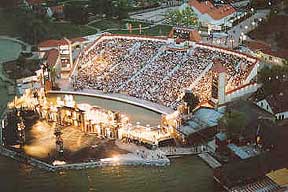 The Morebisch Festspiele seats 7000 for nightly outdoor opera during the summer months in Austria. Wireless microphones are used for principles. These signals are sent through a complex 40 channel Delta Stereophony System for direct sound reinforcement. The E-coustic Systems installation utilizes 48 loudspeakers located on the perimeter of the seating area mounted on poles. It delivers the feeling of spaciousness and envelopment characteristic of a good opera house.
The Morebisch Festspiele seats 7000 for nightly outdoor opera during the summer months in Austria. Wireless microphones are used for principles. These signals are sent through a complex 40 channel Delta Stereophony System for direct sound reinforcement. The E-coustic Systems installation utilizes 48 loudspeakers located on the perimeter of the seating area mounted on poles. It delivers the feeling of spaciousness and envelopment characteristic of a good opera house.Morebisch Festspiele
 E-coustic Systems was used in Mauthausan for a commemorative concert featuring the Vienna Philharmonic Orchestra. Over 120 speakers were attached to steel cables suspended across this quarry. E-coustic Systems processing was taken to the Forbidden City in China for a performance of Turandot presented by the Vienna Staatsoper and the Israeli Philharmonic Orchestra conducted by Zubin Metha.
E-coustic Systems was used in Mauthausan for a commemorative concert featuring the Vienna Philharmonic Orchestra. Over 120 speakers were attached to steel cables suspended across this quarry. E-coustic Systems processing was taken to the Forbidden City in China for a performance of Turandot presented by the Vienna Staatsoper and the Israeli Philharmonic Orchestra conducted by Zubin Metha.Mauthausan
 The Sun Valley Pavilion is host to the Sun Valley Summer Symphony in addition to a variety of touring acts. Loudspeakers mounted on poles throughout the lawn provide both direct sound reinforcement as well as acoustic support which delivers the richness and spaciousness found in the best indoor venues.
The Sun Valley Pavilion is host to the Sun Valley Summer Symphony in addition to a variety of touring acts. Loudspeakers mounted on poles throughout the lawn provide both direct sound reinforcement as well as acoustic support which delivers the richness and spaciousness found in the best indoor venues.Sun Valley Pavilion
